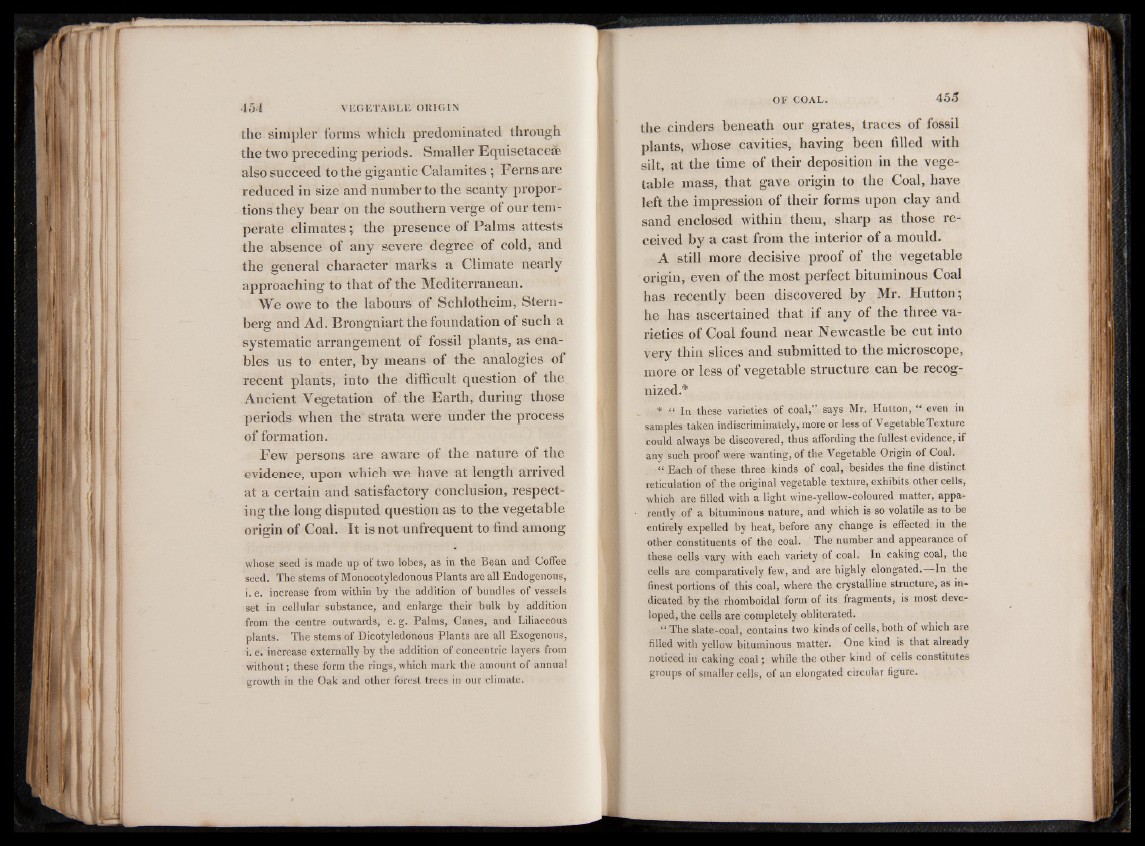
the simpler forms which predominated through
the two preceding periods. Smaller EquisetaceiSe
also succeed to the gigantic Calamites ; Ferns are
reduced in size and number to the scanty proportions
they bear on the southern verge of our temperate
climates; the presence of Palms attests
the absence of any severe degree of cold, and
the general character marks a Climate nearly
approaching to that of the Mediterranean.
We owe to the labours of Schlotheim, Sternberg
and Ad. Brongniart the foundation of such a
systematic arrangement of fossil plants, as enables
us to enter, by means of the. analogies of
recent plants, into the difficult question, of the
Ancient Vegetation of the Earth, during those
periods when the' strata were under the process
of formation.
Few persons are aware of the nature of the
evidence, upon which we have at length arrived
at a certain and satisfactory conclusion, respecting
the long disputed question as to the vegetable
origin of Coal. It is not unfrequent to find among
whose seed is made up of two lobes, as in the Bean and Coffee
seed. The stems of Monocotyledonous Plants are all Endogenous,
i. e. increase from within by the addition of bundles of vessels
set in cellular substance, and enlarge their bulk by addition
from the centre outwards, e. g. Palms, Canes, and Liliaceous
plants. The stems of Dicotyledonous Plants are all Exogenous,
i. e. increase externally by the addition of concentric layers from
without; these form the rings, which mark the amount of annual
growth in the Oak and other forest trees in our climate.
the cinders beneath our grates, traces of fossil
plants, whose cavities, having been filled with
silt, at the time of their deposition in the vegetable
mass, that gave origin to the Coal, have
left the impression of their forms upon clay and
sand enclosed within them, sharp as those received
by a cast from the interior of a mould.
A still more decisive proof of the vegetable
origin, even of the most perfect bituminous Coal
has recently been discovered by Mr. Hutton;
he has ascertained that if any of the three varieties
of Coal found near Newcastle be cut into
very thin slices and submitted to the microscope,
more or less of vegetable structure can be recognized.*
* “ In these varieties of coal,” says Mr. Hutton, “ even in
samples taken indiscriminately, more or less of Vegetable Texture
could always be discovered, thus affording the fullest evidence, if
any such proof were wanting, of the Vegetable Origin of Coal.
“ Each of these three kinds of coal, besides the fine distinct
reticulation of the original vegetable texture, exhibits other cells,
which are filled with a light wine-yellow-coloured matter, apparently
of a bituminous nature, and which is so volatile as to be
entirely expelled by heat, before any change is effected in the
other constituents of the coal. The number and appearance of
these cells vary with each variety of coal. In caking coal, the
cells are comparatively few, and are highly elongated.—In the
finest portions of this coal, where the crystalline structure, as indicated
by the rhomboidal form of its fragments, is most developed,
the cells are completely obliterated.
“ The slate-coal, contains two kinds of cells, both of which are
filled with yellow bituminous matter. One kind is that already
noticed in caking coal; while the other kind of cells constitutes
groups of smaller cells, of an elongated circular figure.